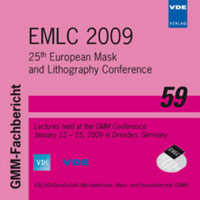MAPPER: High Throughput Maskless Lithography
Konferenz: EMLC 2009 - 25th European Mask and Lithography Conference
12.01.2009 - 15.01.2009 in Dresden, Germany
Tagungsband: EMLC 2009
Seiten: 5Sprache: EnglischTyp: PDF
Persönliche VDE-Mitglieder erhalten auf diesen Artikel 10% Rabatt
Autoren:
Kuiper, V.; Kampherbeek, B. J.; Wieland, M. J.; Boer, G. de; Berge, G. F. ten; Boers, J.; Jager, R.; Peut, T. van de; Peijster, J. J. M.; Slot, E.; Steenbrink, S. W. H. K.; Teepen, T. F.; Veen, A. H. V. van (MAPPER Lithography B.V., Computerlaan 15, 2628 XK Delft, The Netherlands)
Inhalt:
Maskless electron beam lithography, or electron beam direct write, has been around for a long time in the semiconductor industry and was pioneered from the mid-1960s onwards. This technique has been used for mask writing applications as well as device engineering and in some cases chip manufacturing. However because of its relatively low throughput compared to optical lithography, electron beam lithography has never been the mainstream lithography technology. To extend optical lithography double patterning, as a bridging technology, and EUV lithography are currently explored. Irrespective of the technical viability of both approaches, one thing seems clear. They will be expensive. MAPPER Lithography is developing a maskless lithography technology based on massively-parallel electron-beam writing with high speed optical data transport for switching the electron beams. In this way optical columns can be made with a throughput of 10-20 wafers per hour. By clustering several of these columns together high throughputs can be realized in a small footprint. This enables a highly cost-competitive alternative to double patterning and EUV alternatives. In 2007 MAPPER obtained its Proof of Lithography milestone by exposing in its Demonstrator 45 nm half pitch structures with 110 electron beams in parallel, where all the beams where individually switched on and off. In 2008 MAPPER has taken a next step in its development by building several tools. A new platform has been designed and built which contains a 300 mm wafer stage, a wafer handler and an electron beam column with 110 parallel electron beams. This manuscript describes the first patterning results with this 300 mm platform.


